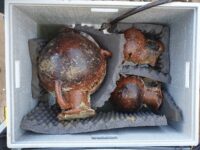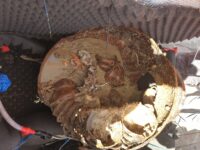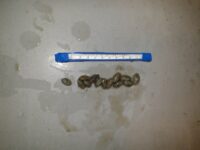 The uniquely well-preserved cargo of an ancient shipwreck found in the Strait of Otranto sheds new light on the early history of the Greek colonization of southern Italy. The wreck was discovered in 2019 at a depth of 780 meters (just shy of a half mile) on the Adriatic seabed off the coast of the Salento area in southern Apuglia. To investigate that deep under water, marine archaeologists from the National Superintendence for Underwater Cultural Heritage employed a submersible Remotely Operated Vehicle (ROV) armed with the latest technologies used in underwater exploration by the oil and gas industries. It was able to uncover part of the wreck and recover 22 ceramic vessels from Corinth dating to the first half of the 7th century B.C.
The uniquely well-preserved cargo of an ancient shipwreck found in the Strait of Otranto sheds new light on the early history of the Greek colonization of southern Italy. The wreck was discovered in 2019 at a depth of 780 meters (just shy of a half mile) on the Adriatic seabed off the coast of the Salento area in southern Apuglia. To investigate that deep under water, marine archaeologists from the National Superintendence for Underwater Cultural Heritage employed a submersible Remotely Operated Vehicle (ROV) armed with the latest technologies used in underwater exploration by the oil and gas industries. It was able to uncover part of the wreck and recover 22 ceramic vessels from Corinth dating to the first half of the 7th century B.C.
 Archaeological material documenting the early stages of Mediterranean trade in the Greek and Illyrian colonies of southern Italy are rare finds in underwater contexts, and since so much commerce then like now took place throughout the Mediterranean basin, the discovery an intact load of cargo is a uniquely rich source of data for researchers. The objects are now in the National Superintendence’s restoration laboratory in Taranto.
Archaeological material documenting the early stages of Mediterranean trade in the Greek and Illyrian colonies of southern Italy are rare finds in underwater contexts, and since so much commerce then like now took place throughout the Mediterranean basin, the discovery an intact load of cargo is a uniquely rich source of data for researchers. The objects are now in the National Superintendence’s restoration laboratory in Taranto.
The 22 vessels consist of three amphorae of Corinthian A type, 10  Corinthian skyphoi, four Corinthian hydrias, three trilobite oinochoai and one coarse ceramic jug of a very common Corinthian type. One of the large amphorae, which was partially broken, still contained a remarkable curving stack of nested skyphoi. There are at least 25 of them, plus fragments from other cups. More may be revealed when the thick deposits of marine sediment are removed from the pithos.
Corinthian skyphoi, four Corinthian hydrias, three trilobite oinochoai and one coarse ceramic jug of a very common Corinthian type. One of the large amphorae, which was partially broken, still contained a remarkable curving stack of nested skyphoi. There are at least 25 of them, plus fragments from other cups. More may be revealed when the thick deposits of marine sediment are removed from the pithos.
That sediment has archaeological value as well. Researchers will analyze  organic and plant residues that may have been trapped in the sediment for evidence of what the vessels transported. One of the Corinthian A amphorae has already been found to contain numerous olive pits. Based on remote documentation of the site, there are still about 200 artifacts scattered on the seabed. The Culture Ministry plans to systematically recover them all.
organic and plant residues that may have been trapped in the sediment for evidence of what the vessels transported. One of the Corinthian A amphorae has already been found to contain numerous olive pits. Based on remote documentation of the site, there are still about 200 artifacts scattered on the seabed. The Culture Ministry plans to systematically recover them all.
This video has some cool footage of the robotic arm of the ROV recovering fragile ceramics from the wreck site.
Of interest would also be, how far already the Mycenaean or pre-Classical trade had been developed.
In ‘Magna Graecia’, Greek was certainly understood. However, this is –according to Herodotus– how Phoenician had traded with Africans, “outside the Pillars of Heracles”.
Arguably, Pharaoh Necho II, who reigned 610–595 BC, had a canal cut to connect to the Red Sea. At some point in between, he had sent a Phoenician expedition all around Africa.
:hattip:
———-
“..[dwellers] to whom they have come and have taken the merchandise forth from their ships, they set it in order along the beach and embark again in their ships, and after that they raise a smoke; and the natives seeing the smoke come to the sea, and then they lay down gold as an equivalent for the merchandise and retire to a distance away from the merchandise. The traders, upon that, disembark and examine it, and if the gold is in their opinion sufficient for the value of the merchandise, they take it up and go their way; but if not, they embark again in their ships and sit there; and the others approach and straightway add more gold to the former, until they satisfy them. They say that neither party wrongs the other; for neither do the traders lay hands on the gold until it is made equal to the value of their merchandise, nor do the others lay hands on the merchandise until the traders have taken the gold.”
———-